The maximum slope of the sewer per 1 meter. What should be the slope of the external sewage pipes
When designing a home drain, you first need to know which slope to set for the sewer.
The simplicity of the sewer installation is silent about many small nuances, non-observance of which can adversely affect a particular situation.
One of the most important points is the choice of the angle of inclination.
An incorrect angle of inclination can cause a backlash - and everything that is lowered into the toilet or sink will return to you, or even rule out adequate operation.
Many inexperienced plumbers do not even know about such a concept as excessive bias. Everyone is accustomed to believing that if the slope is very “steep”, then the waste in this case will drain much faster, and the return of the waste will not happen.
In fact, this is not entirely correct, but this approach has the other side of the coin.
 If the pipe has a steep descent, siltation occurs inside it, since the water leaves very quickly. All sewage not washed away by water sticks to the walls, thereby clogging it.
If the pipe has a steep descent, siltation occurs inside it, since the water leaves very quickly. All sewage not washed away by water sticks to the walls, thereby clogging it.
Disruption of water constipation in siphons can also happen, subsequently, an unpleasant smell will enter the house. Agree, it will not be a very pleasant moment, especially if there are guests in the house.
Another important reason to keep the pipes constantly in the water is the influx of air to the surfaces, which will cause corrosion, reducing their service life. Therefore, you must adhere to the correct bias not only in the house, but also outside it.
Maximum slope for outer pipe - 0.15, i.e. no more than 15 centimeters per meter. At values \u200b\u200babove this, the system will be completely ineffective.
Minimum bias
Many newly built plumbers or novice builders who independently conduct drainage, face a problem, which is the units of measurement of the slope of the pipe.
In any instruction or reference materials for setting the minimum slope of sewer pipes you will find only decimal fractions of the form 0.02, which means that for every meter there are 20 millimeters of slope.
An important factor is the calculation of the coefficient of fullness.
It is calculated as follows: the height of the water level in the pipe divided by the diameter. The most optimal value will be the variation of the coefficient in the range from 0.5 to 0.6.
Calculation according to SNiP
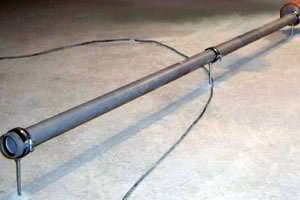 Referring to the rules of SNiP, it can be interpreted that the minimum slope for sewage in an apartment or a country house depends, first of all, on its diameter.
Referring to the rules of SNiP, it can be interpreted that the minimum slope for sewage in an apartment or a country house depends, first of all, on its diameter.
As an example, the slope of a 50 mm sewer pipe is 3 centimeters per meter per hundred square meters.
Basic rules of SNiP:
- For collectors, the angle of inclination is calculated depending on the filling, flow rate and speed of waste transportation.
- The slope of the pipe should be within acceptable limits and not exceed them.
- The slope coefficient indicates the number of meters of slope per linear meter of sewer pipe.
- In SNiP you will never find the calculation of the angle of inclination in degrees.
Calculation table for pipes of different diameters
 Take, for example, the installation and removal of the sewer pipe from the toilet. Here it is best to use a pipe with a diameter of 100.
Take, for example, the installation and removal of the sewer pipe from the toilet. Here it is best to use a pipe with a diameter of 100.
As you can see in the table, the slope according to SNiP is 1/20, this means 1 meter divided by 20, total 5 centimeters for each linear meter of the pipe.
In this way, you can calculate the necessary slope for absolutely any plumbing fixtures.
Please note that when installing the sewage system, it is worth considering what you are leading it from. For washing, for example, it is not recommended to use pipes with a diameter greater than 50 millimeters, and for a toilet - a maximum of 100 millimeters.
For 110th diameter

Most often used for general drainage and tapping into the central city sewer.
The angle of inclination can vary from 5 to 15 centimeters per linear meter of pipe.
Here, in the first place, the number of connections, various turns and the remoteness of the house from the central city sewage system will play.
Please note: pipes of such a large diameter are only suitable for laying branches to the central sewer and for removing waste from the toilet.
They can also be used for a riser if the house has several floors. For sewage from a kitchen sink, bathtub, washing machine, washbasin, etc. use pipes exclusively 40-50 mm in diameter.
And finally, the video - installation of sewers with the correct slope. Practical methods.
Sewerage in your own house is a necessary engineering system that increases comfort for the residents of the cottage or cottage. Proper arrangement of the sewage system, both inside the house and outside it, is an important and uncomplicated task. The main thing is to approach the issue with full awareness, then it will be possible to do all the work yourself.
What is sewer pipe slope?
An external sewage system involves conducting pipes to drain the spent liquid from the house. In order for the outflow to be correct and meet all installation requirements, sewer pipes must be placed at a certain slope, which is calculated by the formula and measured in decimal fractions.
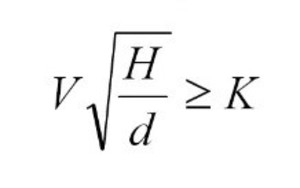 where:
where:
- V is the discharge rate of wastewater in m / s;
- H - pipeline filling;
- D is the diameter of the sewer pipe;
- K is the slope coefficient.
In addition to calculations, to determine the level of the slope of the sewer pipe, you can already use known indicators depending on the diameter of the pipe per 1 meter of its length. For pipes with a diameter of 5 cm, the top edge of the pipe should be above the bottomafter 1 meter by 3 cm. Sewer pipes with a diameter of 11 cm should be installed with a slope of at least 2 cm per meter pipe lengths. A pipe with a diameter of 16 cm should be mounted so that the slope is at least 0.8 cm
What affects the slope of the sewer pipe
Gravity drainage is a standard solution that is used in private homes. To sewer pipes not clogged and served as long as possible, you need to correctly set the slope of the drain system. Sewer Pipe Angle should not be too big, as this will affect its performance.
- The pipe can quickly fail, as it turns out that the solid fractions will not be washed off due to the rapid flow. And this in turn can lead to the formation of sludge inside the sewer pipe and its subsequent cleaning.
- If the pipe is strongly inclined and at the same time long, then the siphon shutter may be disrupted, that is, the sewage system will be disrupted, and all the unpleasant smell will rush into the house.
- When using metal pipes and the wrong choice of the angle of their inclination, when draining, the upper part will be filled with air, which will contribute to the development of metal corrosion and the failure of the pipe.
In addition to the listed negative factors exceeding the angle of inclination of the pipes will significantly increase the noise level during the drain of used water and flushing of feces.
How to calculate pipe angle?
![]() The main parameter that you need to use to calculate the angle of the sewer pipe is speed of movement sewage flow. It is determined by the normative value (SNiP "Slope of gravity drainage"), the minimum flow rate is 0.7 m / s. Only recommendations can be used. normative documentwhich indicates all the nuances for the sewer device. At the same time, SNiP reflects such moments as the device domestic sewage, storm sewage, and also indicates that when calculating the angle of inclination, you need to focus on one more indicator - pipe fill level. The normative value of this indicator is at least 30%, but it directly depends on the flow rate and on the material and the diameter of the pipes.
The main parameter that you need to use to calculate the angle of the sewer pipe is speed of movement sewage flow. It is determined by the normative value (SNiP "Slope of gravity drainage"), the minimum flow rate is 0.7 m / s. Only recommendations can be used. normative documentwhich indicates all the nuances for the sewer device. At the same time, SNiP reflects such moments as the device domestic sewage, storm sewage, and also indicates that when calculating the angle of inclination, you need to focus on one more indicator - pipe fill level. The normative value of this indicator is at least 30%, but it directly depends on the flow rate and on the material and the diameter of the pipes.
In order that after calculations, the sewage system is installed at the correct slope, land works. Any unevenness at the bottom of the trench can cause sewage to function improperly. Therefore, before laying and connecting the pipes, you need to check the level tilt of the trench.
It is possible to calculate the level of pipe inclination without resorting to reading SNiPa, for example, use the recommendations already calculated indicators for a specific pipe diameter. Well-known facts are as follows: for pipes with a diameter of not more than 50 mm, the slope for each running meter should be no more than 3 cm and for sewer polypropylene pipes of large diameters, for example 110 mm - 2 cm by 1 meter pipe lengths.
How to measure the angle of the pipe?
The layout of the internal sewage system involves the laying of pipes inside the house, and each of the places of water use different pipe diameters therefore, the angle of inclination inside the house cannot be determined by only one value.
- For pipes that extend from sinks, bathtubs or showers, with a diameter of 40-50 mm, the slope of the sewer pipe should vary from a minimum of 2.5 cm per meter of length, to 3.5 cm per linear meter of the pipeline.
- When connecting the toilet to a sewer pipe with a diameter of 10 cm, its angle of inclination varies from 1.2 cm to 2 cm per 1 meter.
![]() In order to measure the required slope indoors, you can use different building levels- from laser, which can determine the correct direction, to small magnetic levels that are installed on the pipe itself. They have 3 stripes on each side, each of which equal to 1 cm slope.
In order to measure the required slope indoors, you can use different building levels- from laser, which can determine the correct direction, to small magnetic levels that are installed on the pipe itself. They have 3 stripes on each side, each of which equal to 1 cm slope.
When laying an external pipeline, it is necessary to take into account not only the calculated values \u200b\u200bof the slope, but also pipeline occupancy. So, for houses of large number of storeys, respectively, and the number of people living in the house, and therefore the number wastewater, there will be much more values \u200b\u200bgiven for private homes. During the construction of a house and the arrangement of sewers, take into account, among other things, the pipe fill rate so that the sewage system in the house worked without interruption.Therefore, the angle of the sewer pipes in a multi-storey building for each project is determined separately, but guided by this SNiP.
In a private house, for the sewage system, they make calculations or use recommendations. The only thing to consider is the so-called non-standard situations. For example, the depth of freezing of the soil or the laying of pipes below a predetermined level for other reasons, should contribute to an increase in the slope of the sewer. Since the main task in its arrangement is that drains must not clog the pipe.And if the slope is too sharp or if it is unreasonably increased, all solid waste will accumulate inside the sewer. This will inevitably lead to clogging and alteration. You can measure the incline level outdoors using the same devices as at home.
Sewer slope and their methods of exposure
The use of various tools in the process of laying sewers is a reasonable and correct solution. Almost impossible to determine by eye acceptable slopeand during the installation of pipes to make sure that it does not change. Therefore, when a sewage device is used various devices- level, water or normal level and other devices.
For long sewer pipes (the total length of the entire line) can be done this way: first connect all the pipes into one, and then use the level set the correct tilt.But it's hard to cope alone. Since while one person is adjusting the level of the pipe, the other should follow beyond the level marks and lead the process.
If you use a water level, it is better to choose one that has a circular recess at its bottom, since it will hold onto the pipe while you can adjust her position. It is especially convenient to use this level on metal pipes, because a magnet is built into its bottom, which will keep the level on the pipe.
Inside the house, laying sewer pipes is the easiest in terms of setting the required level, since you can use any tool to determine the angle of inclination (up to the usual ruler).
For the wastewater system to work properly, there must be a certain angle of inclination of the sewage system, since without it the water will stagnate in the pipes.
In the case when the sewage slope is too small, the wastewater will not be able to flow out completely, but will form blockages in the form of plugs. But too large a slope is also not beneficial, because in this case, solid wastewater elements can settle on the walls of the sewage system, and after a while blockages will form and the pipe will wear out ahead of time.
That is why, there is such a thing as a minimum sewage slope, which guarantees a normal drainage of sewage. To calculate the angle of inclination, there are special formulas. You can learn more theory about them by studying SNiP. Practice shows that the slope should be approximately 2 cm per 1 linear meter of sewer pipe.
![]() To carry out the calculation and determine the desired angle of inclination, in principle, is not difficult, but pure water is certainly taken into account in the calculation. And in effluents there are usually plenty of fecal elements that tend to freeze at a certain temperature and clog up the effluents. Subsequently, the sewage system becomes clogged and requires cleaning.
To carry out the calculation and determine the desired angle of inclination, in principle, is not difficult, but pure water is certainly taken into account in the calculation. And in effluents there are usually plenty of fecal elements that tend to freeze at a certain temperature and clog up the effluents. Subsequently, the sewage system becomes clogged and requires cleaning.
Therefore, the sewage slope according to SNiP is taken into account even at the stage of developing a project for building a house. It SNiP regulates the construction of sewer systems. If you do not take into account the slope of the sewage system by 1 meter, then this will entail oversights that will affect the operation of the system.
Please note that the angle of inclination is not calculated in degrees. The slope of the sewage pipes is not measured in degrees for the reason that the pipeline, even with minimal oversight, may not be laid correctly. As a result, traffic jams will often form in the sewer, and it will need to be cleaned.
Domestic sewage system
When installing the internal sewage system in the room, it is recommended to use plastic pipes with a cross section of 50 and 110 mm. To connect any device, with the exception of the toilet, you can use a pipe whose diameter is 50 mm.
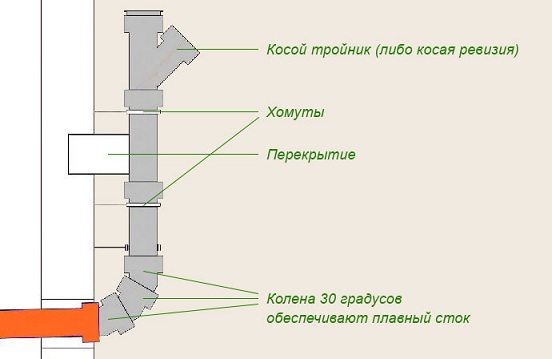 Tips for installing an internal sewer:
Tips for installing an internal sewer:
- Do not allow pipe turns in a horizontal position at right angles. It is necessary to use bends with an angle of 45 degrees.
- For pipes in an upright position, a right angle is prohibited.
- At a small distance with a short pipe length, the slope can exceed the norm.
By the way, according to SNiP, it is forbidden to change the types of wiring of the sewer slope. At the same time, the slope of the sewage system per 1 meter must be calculated in accordance with the recommendations of regulatory documents.
Outdoor sewage
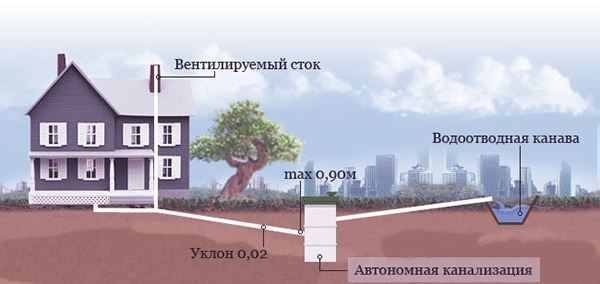 The task of the system is the removal of contaminated water from the house to the septic tank. You can use any pipes: cast iron, corrugated or asbestos-cement.
The task of the system is the removal of contaminated water from the house to the septic tank. You can use any pipes: cast iron, corrugated or asbestos-cement.
The depth of the trench can vary from 0.7 m to 2 m. This indicator depends on the climatic conditions in the region.
To correctly calculate the slope, you need to pull the rope from the beginning to the end of the dug trench. The bottom of the trench should be level, and then the optimal angle of inclination is measured.
When installing outdoor sewagemainly pipes with a diameter of 110 to 200 mm are used. In this case, the minimum slope of the sewage system according to SNiP should be equal for pipes with a diameter: 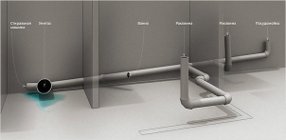
- 110 mm - 0.03;
- 160 mm - 0.008;
- 200 mm - 0.007.
It is logical that the slope of the external sewage system according to SNiP for each section will be different. It must be borne in mind that the slope of the external sewage system by 1 meter according to SNiP should not exceed 15 cm, otherwise it simply will not be effective.
The sewage line must be laid at a depth that is less than the freezing level by 30 cm.
If the pipes are laid higher, then additional thermal insulation will be needed.
Storm sewer
purpose storm sewer consists in the removal of rain and melt water from the house, in order to avoid waterlogging of the area. All requirements for its installation are indicated in SNiP.
Before you begin the installation of storm sewers, you need to perform a calculation. For this calculation, you need the following information:

To determine the minimum slope of storm sewers according to SNiP, you need to take into account such indicators:
- Type of drainage.
- Pipe diameter.
- Surface coating.
 The minimum slope of storm sewers in relation to the diameter of the pipe should be:
The minimum slope of storm sewers in relation to the diameter of the pipe should be:
- 200 m - 0.7 cm;
- 150 m - 0.8 cm.
According to SNiP, the slope of storm sewers by 1 meter can be reduced by 2 mm, if this is a necessary step in connection with local conditions. In general, the slope of storm sewers according to SNiP should not exceed 1.5 cm per meter of pipe.
Pressure sewer
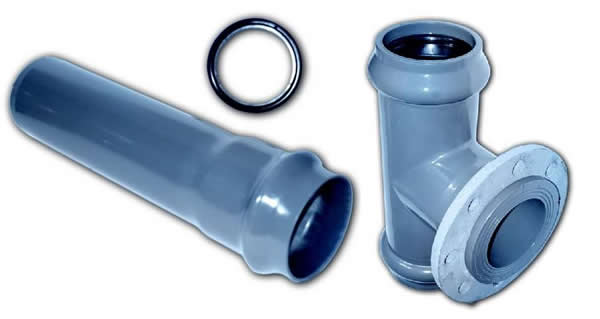 The calculated data on the slope of gravity sewage according to SNiP must be strictly observed for the normal operation of the sewer system. The essence of the pressure sewage system is to collect wastewater into a storage tank, and then they are transported through a pump.
The calculated data on the slope of gravity sewage according to SNiP must be strictly observed for the normal operation of the sewer system. The essence of the pressure sewage system is to collect wastewater into a storage tank, and then they are transported through a pump.
You can find out the maximum distance for pumping pressure sewage using the SNiP recommendations, which list all the necessary formulas and coefficients.
Advantages of pressure sewer:

However, with such positive characteristics, you still need to obey the requirements dictated by regulatory documents.
Pressure absorber
 To reduce the pressure of wastewater it is necessary to use a sewage pressure damper, which is responsible for the difference in the flow rate of wastewater. Install a damper well according to a standard design, to which changes can be made. Reflects the characteristic about the sewer pressure damper well - a drawing in which the design of the damper well is decoded.
To reduce the pressure of wastewater it is necessary to use a sewage pressure damper, which is responsible for the difference in the flow rate of wastewater. Install a damper well according to a standard design, to which changes can be made. Reflects the characteristic about the sewer pressure damper well - a drawing in which the design of the damper well is decoded.
The well has the form of a cylinder-shaped container, to the bottom of which pipes are connected at different heights. Wastewater flows through the upper pipe into a tank and then flows through the lower pipe. As a result of this drop, the pressure is suppressed inside the chamber.
What is the harm of excessive or insufficient bias?
 Very often, inexperienced builders make the slope of the pipe as much as possible so that polluted water is discharged as soon as possible. However, this is a mistake, because if the drain is too steep, sewage starts to flow out too quickly, without having time to wash off larger and harder fecal elements, as a result of which the sewer pipe becomes clogged.
Very often, inexperienced builders make the slope of the pipe as much as possible so that polluted water is discharged as soon as possible. However, this is a mistake, because if the drain is too steep, sewage starts to flow out too quickly, without having time to wash off larger and harder fecal elements, as a result of which the sewer pipe becomes clogged.
Another mistake with unfavorable consequences is unfilled pipes.
It is not allowed to leave the pipes incompletely filled, as the influx of air under aggressive environmental conditions leads to corrosion of the pipe. Because of this, the life of the sewer pipe will be significantly reduced.
 The same result is obtained due to insufficient slope of the sewage system. With this slope, the speed of wastewater cannot wash large fractions from the pipe walls. As a result, it becomes clogged with silt and requires cleaning.
The same result is obtained due to insufficient slope of the sewage system. With this slope, the speed of wastewater cannot wash large fractions from the pipe walls. As a result, it becomes clogged with silt and requires cleaning.
SNiP carefully ensures that the design and installation of sewer systems are strictly carried out. At the same time, the slope of the sewage system per 1 meter of SNiP inevitably affects the life of the sewer system and the quality of its work.
For the drainage system, pipes cannot be installed in any order. A slight slope of the sewer structure will lead to blockages. If the slope is large, leaks will appear and noise will occur.
The slope of the pipe depends on its length, the longer it is, the greater the slopeThe walls of sewer networks are overgrown with stratification over time, since waste water contains trash and food debris.
The optimum angle is displayed in centimeters. There are special standards and calculations are carried out to determine it.
How to calculate the slope
Minimum the angle of inclination depends on the diameter of the pipes. According to SNP standards, the following values \u200b\u200bare accepted:
- With a diameter of 50 mm or more, the value is 0.03.
- For elements with a cross section from 85 to 100, this indicator is 0.02.
This value indicates the ratio of the lowering height to the length of the system.
When creating a project, it is important to take into account the turns and connections of the trunk, as well as the points of discharge of drains.
For plumbing equipment, there are standards when creating bends:
- for the washbasin, products with a diameter of 40 to 50 mm are selected, and the minimum sewage slope is from 0.25;
- for toilets, this value is 0.12 - 0.02.
When installing external systems, calculations are carried out. For this, a pipeline of a larger diameter is used than when installing intra-house communications.
The following rules apply:
- For pipes with a diameter of 150, a slope of 0.08 is selected.
- When using structures with a cross section of 200 mm, the slope is 0.07-0.05.
There are restrictions on the possible value. For an outdoor circuit, the indicator is 0.15. The angle of the sewer to 1 meter is 15 cm.
A gradual reduction is performed so that the solids in the system are in suspension. This prevents adhesion to the surface of the walls of structures.
In short sections, from the sink to the bathroom, it is not so important to consider the slope.
To determine the desired decrease, a level is used, since not all floors have a flat surface.
If you can’t make the desired slope. That selects the maximum allowable level of decline. The pipe 150 has a value of 0.07. For highways of 200 mm - 0.05.
In multi-apartment buildings, structures are stacked with a uniform decrease. In this case, an uninterrupted flow of drains occurs. If the bias is violated, the branch bends and blockages occur.
Optimum sewer slope of 1 meter contributes to a speed of 0.7-1 meters per second. In this case, solids do not settle on the wall surfaces, but are in suspension.
Inclination of the internal pipeline
The gradual decrease and the value of snip pipes depends on a certain section. In the bathroom and in the kitchen, various highways are used. Water supply and sewerage is carried out taking into account certain parameters.
When installing the toilet, highways with a cross section of 100 mm are used, while the decrease varies from 0.012 to 0.02.
For washbasins, bathtubs and sinks in the kitchen, products are selected in 50 or 40 mm. In this case, the normal angle of the pipe is considered to be 0.035-0.025.
For accurate calculation, a bubble level is used. If you immediately select the right tool in the future, you don’t have to redo the sewer system.
When installing an internal sewage system, the following recommendations apply:
- Do not apply highway turns at right angles. Offsets at an angle of 45 degrees are recommended.
- If the elements are arranged vertically, then right angles are used.
- When turning the structure, special connections are made to control the structure.
If the pipes are short, then the percentage slope is more than necessary.
Changes to snippet gradients are prohibited. This will lead to violations of the hydrodynamic characteristics. This will cause water hammer. In some cases, a counterclone is performed.
Sewer construction is a gravity flow system. For its normal operation, and you need to determine the bias. This means that the lines are not laid horizontally, but with a slope so that the liquid flows naturally.
It is necessary to calculate the slope correctly. This value is approximately two cm per linear meter of line. This means that each meter of the circuit is two centimeters lower than the previous one. All SNP values \u200b\u200bare determined at the design stage.
The angle of the highway is measured in centimeters. This is not done in degrees to exclude errors during installation work. Such shortcomings lead to congestion and traffic jams, which will require cleaning of the structure.
Sewer pipe standards
And the sewers contain standard sizes for laying the system. The diameter of the outer lines is larger than the internal structures.
For an element with a diameter of 150 mm, a slope of 0.008 is required. For a larger cross section, this value is reduced.
With a large slope, the liquid will not clean the walls of solid sewage and the lumen will narrow over time.
The dimensions of the plastic elements for sewage depend on the application: internal or external sewage.
WATCH THE VIDEO
Outdoor products will have more wall thickness. The following standard pipes are available:
- Polypropylene pipes have the following standard section sizes: 50, 40 or 110.
- Products made of high density polyethylene are wound into coils. They are pressureless and pressureless. Their diameters are 50, 90 or 110.
- PVC lines are available in cross sections from 10 to 315 mm.
Sewer pipes are resistant to aggressive environments. Quality products are characterized by smoothness, which prevents the formation of blockages. Pipes are laid in industrial and domestic soils. Pipes are characterized by low thermal conductivity, which prevents freezing.
The entire sewage disposal system, mainly in private buildings, is based on the principle of water flow in a natural way, that is, by gravity. For the normal operation of this system, there must be a certain slope of the sewer. This means that the pipes should not be horizontal, but a slight slope is necessary so that the water flows under the action of gravity and does not stagnate in the pipes.
If the slope of the pipeline is too small, the wastewater will not flow out completely, resulting in congestion and congestion. If the slope of the pipes is too large, solid wastewater fractions can settle on their walls, which will also lead to the formation of plugs and wear of the pipes.
Therefore, there is a concept - the minimum slope of the sewage system, in which a normal flow of water is guaranteed. There are special formulas for calculating this value, however, from practice it is known that the slope should be approximately two centimeters per linear meter of pipe. This means that every meter of the subsequent pipe should be two centimeters lower. It is not difficult to calculate and make the required level of pipe inclination. Consider a small example: the length of the drain pipe is 10 meters, which means that the horizontal distance between the beginning and the end of the pipe will be twenty centimeters.
But this only takes into account relatively clean water. And in the effluents there are a lot of solid fecal fractions and fat, which solidify at a certain temperature and can accumulate on the walls of pipes. This can lead to the fact that the sewage system will often become clogged and it will be necessary to periodically clean it.
|
|
Therefore, SNiPom (construction norms and rules) determines the order of construction of sewer systems. SNiP the slope of the sewer pipe is taken into account already at the stage of the project of a private house or any other structure.
In accordance with these rules, pipelines with a diameter of up to 50 millimeters must have a slope of three centimeters per meter of pipe, and with a pipe section of up to 100 millimeters this figure is already two centimeters.
The slope of the SNiP sewer pipe is taken into account only in centimeters, and this value is never measured in degrees. Experts do not determine the slope of the drain pipes in degrees because even with a minimal error, the pipeline may not be laid correctly. And this will lead to an unbalanced operation of the sewer system, there will be congestion, traffic jams and pipe cleaning will be required.

Slope of pipelines of the internal sewerage system
Some expert advice when installing an internal sewer:
- pipe turns at right angles when they are horizontal are not allowed, bends with an angle of 45 degrees should be used;
- with a vertical arrangement of pipes, right angles are permissible;
- in places of pipe rotation, revision connections should be made to monitor and repair the system;
- at a small distance with a short pipe length, the slope can be made large (more than the permissible norm).
It should be noted that the SNiP sewage slope within the site does not allow changing the types of wiring. Otherwise, the hydrodynamic characteristics of the pipeline will be violated, which can lead to water hammer and, as a result, pipe failure. If during the laying of pipes there is any obstacle, then it is better to get around it.
Calculation of the slope of the sewer during the installation of an external system
The external sewage system is designed to deliver wastewater from the house to the septic tank. Pipes for this can be used various:
- cast iron
- asbestos cement,
- corrugated polyethylene elements.
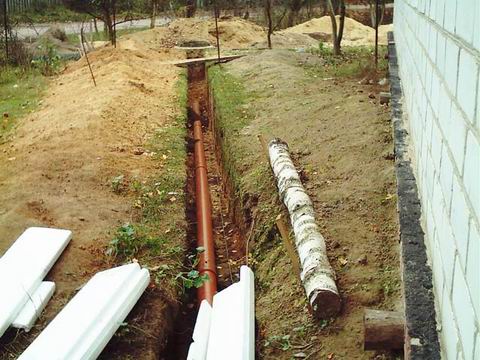
The depth of the trench, depending on the climatic conditions of the region, can range from 70 centimeters to two meters.
The bottom of the trench should be about 20 centimeters deeper than the planned level.
This value depends on the diameter of the pipe, and it may also be necessary to add bedding to even out the level of pipe passage.
In order to make the correct slope of the sewage system, it is necessary to drive two pegs at the beginning and end of the trench and pull the rope. In this case, the bottom of the trench can be made even, without holes and deflections, and set the optimum angle of inclination of the pipes. Then, at the bottom of the ditch, it is necessary to make a pillow of sand about five centimeters thick so that the pipeline lies flat and there are no hard protrusions that can damage the pipeline.
In the construction of a system for the disposal of wastewater and waste, slope of the pipes plays an important role. It is important to comply with sewage slope standards for normal and trouble-free operation of the entire system. Depending on the length of the pipeline, the diameter and material of the pipes, the slope should be from 1.5 to 3 centimeters per linear meter of pipe. These values \u200b\u200bare tested by the time and practice of specialists.
